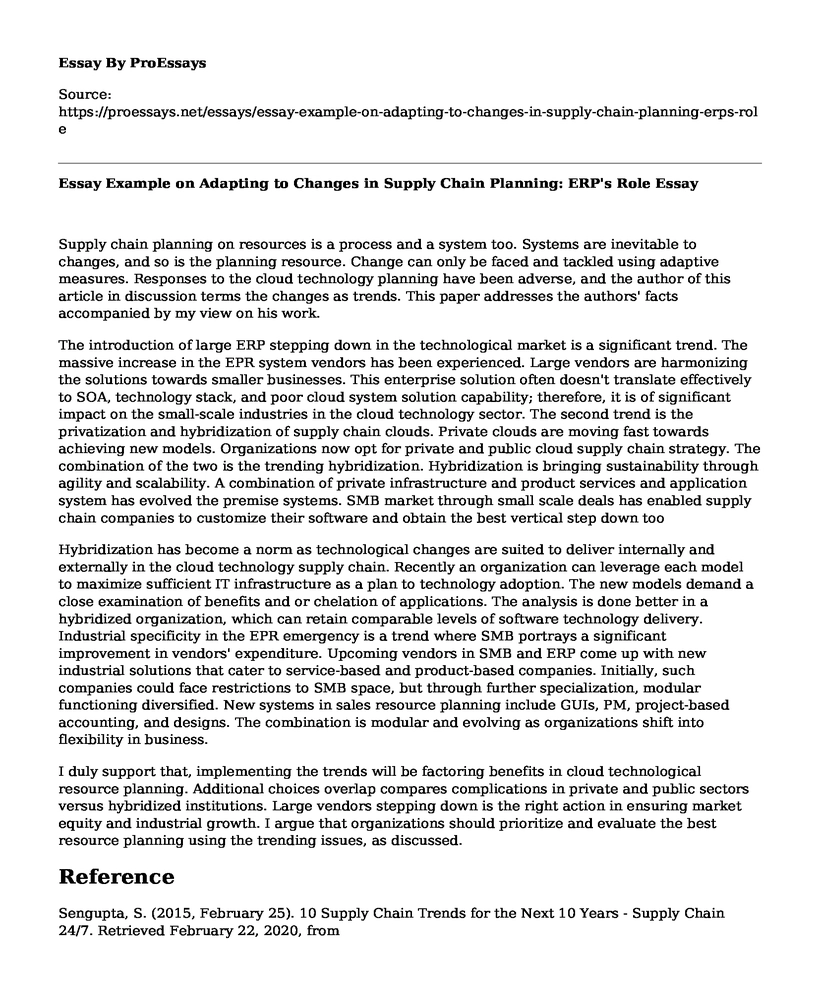Supply chain planning on resources is a process and a system too. Systems are inevitable to changes, and so is the planning resource. Change can only be faced and tackled using adaptive measures. Responses to the cloud technology planning have been adverse, and the author of this article in discussion terms the changes as trends. This paper addresses the authors' facts accompanied by my view on his work.
The introduction of large ERP stepping down in the technological market is a significant trend. The massive increase in the EPR system vendors has been experienced. Large vendors are harmonizing the solutions towards smaller businesses. This enterprise solution often doesn't translate effectively to SOA, technology stack, and poor cloud system solution capability; therefore, it is of significant impact on the small-scale industries in the cloud technology sector. The second trend is the privatization and hybridization of supply chain clouds. Private clouds are moving fast towards achieving new models. Organizations now opt for private and public cloud supply chain strategy. The combination of the two is the trending hybridization. Hybridization is bringing sustainability through agility and scalability. A combination of private infrastructure and product services and application system has evolved the premise systems. SMB market through small scale deals has enabled supply chain companies to customize their software and obtain the best vertical step down too
Hybridization has become a norm as technological changes are suited to deliver internally and externally in the cloud technology supply chain. Recently an organization can leverage each model to maximize sufficient IT infrastructure as a plan to technology adoption. The new models demand a close examination of benefits and or chelation of applications. The analysis is done better in a hybridized organization, which can retain comparable levels of software technology delivery. Industrial specificity in the EPR emergency is a trend where SMB portrays a significant improvement in vendors' expenditure. Upcoming vendors in SMB and ERP come up with new industrial solutions that cater to service-based and product-based companies. Initially, such companies could face restrictions to SMB space, but through further specialization, modular functioning diversified. New systems in sales resource planning include GUIs, PM, project-based accounting, and designs. The combination is modular and evolving as organizations shift into flexibility in business.
I duly support that, implementing the trends will be factoring benefits in cloud technological resource planning. Additional choices overlap compares complications in private and public sectors versus hybridized institutions. Large vendors stepping down is the right action in ensuring market equity and industrial growth. I argue that organizations should prioritize and evaluate the best resource planning using the trending issues, as discussed.
Reference
Sengupta, S. (2015, February 25). 10 Supply Chain Trends for the Next 10 Years - Supply Chain 24/7. Retrieved February 22, 2020, from https://www.supplychain247.com/article/10_supply_chain_trends_for_the_next_10_years
Cite this page
Essay Example on Adapting to Changes in Supply Chain Planning: ERP's Role. (2023, Apr 09). Retrieved from https://proessays.net/essays/essay-example-on-adapting-to-changes-in-supply-chain-planning-erps-role
If you are the original author of this essay and no longer wish to have it published on the ProEssays website, please click below to request its removal:
- The Compensation of CEOs
- Research Paper Sample: The Psychology of Advertising
- American Foundation for Suicide Prevention Organization Overview
- The Blue Cross Blue Shield of Massachusetts Scenario Planning Process Paper Example
- Line Organization Structure of Baptist Hospital Paper Example
- Essay Example on Real Estate Sec. Market: 20 Yrs of Growth & Risk Impact
- Evaluating the External Environment - Free Essay Example







